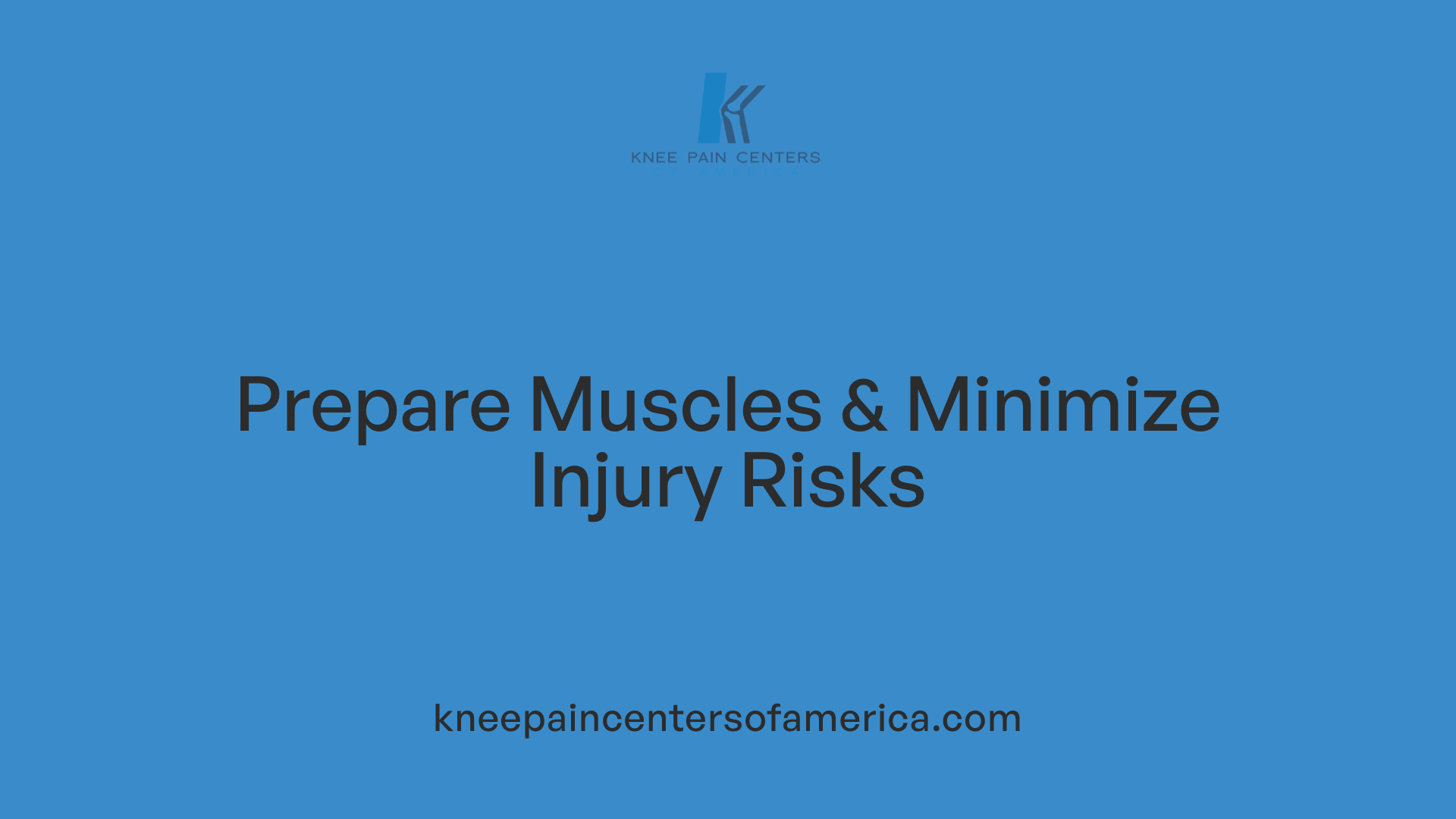Understanding the Importance of Joint Care in Osteoarthritis
Knee osteoarthritis (OA) is a prevalent condition that causes pain, stiffness, and reduced function, significantly impacting quality of life. While treatments vary, managing physical activity through warm-ups and cool-downs plays a crucial role in protecting the joints and enhancing recovery. This article explores how these preparatory and recovery techniques support joint health and integrate with medical and therapeutic strategies for knee osteoarthritis.
Why Warm-Ups Are Vital for Joint Preparation and Injury Prevention

Physiological Effects of Warming Up
Warming up increases body temperature and widens blood vessels, boosting oxygen supply to muscles. This results in muscles becoming warmer, looser, and more pliable, which enhances their ability to support joints during exercise. For knee osteoarthritis patients, this improved muscle function helps protect the joint by reducing strain and potentially slowing disease progression.
Duration and Methods of Warm-Ups
Experts recommend spending about five minutes on warm-ups, gradually increasing activity intensity. This could involve gentle walking before running or slow laps before cycling. Longer or more strenuous activities warrant longer warm-up periods to fully prepare muscles and joints.
Safety Benefits Specifically for People with Knee Osteoarthritis
Warming up eases joint strain and lowers the risk of injury, which is particularly important for individuals with knee OA. It reduces cardiovascular strain while improving muscle support around vulnerable joints, making physical activity safer and more effective.
Types of Dynamic Warm-Up Exercises Suitable for Joint Health
Dynamic warm-up exercises that activate key muscle groups and joints include leg swings, walking lunges, hip circles, and arm circles. These movements enhance mobility and joint function which are crucial for maintaining knee health.
Role in Reducing Cardiovascular Strain and Improving Muscle Function
Warm-ups help the cardiovascular system by gradually raising heart rate and blood flow, preparing the body to handle increased demands. Better muscle conditioning from warming up also helps prevent injuries and supports joint stability, contributing to overall joint health and improved exercise performance.
Cooling Down: Facilitating Recovery and Reducing Joint Stress

How do cool-down routines benefit recovery and joint health in knee osteoarthritis?
Cooling down after exercise plays a crucial role in recovery for individuals with knee osteoarthritis (OA). It helps the heart rate gradually slow down, reducing strain on the cardiovascular system and allowing the body to return to a resting state safely. Additionally, cooling down alleviates muscle tension and reduces soreness, which minimizes joint stress and lowers the risk of injury in the affected knees.
What activities are recommended during cool-down for knee OA patients?
Recommended cool-down activities include light walking to gently decrease the heart rate and promote blood circulation. Static stretching targeting key muscle groups such as hamstrings, calves, hip flexors, and quadriceps is advised to improve flexibility and relieve muscle tightness. Techniques like foam rolling may also be used to reduce muscle tension and ease joint stress.
Why is gradual heart rate reduction important in the cool-down phase?
A gradual heart rate reduction facilitates a smooth transition from active to rest states, preventing dizziness or blood pooling that can occur if activity stops abruptly. This easing also supports cardiovascular safety and allows muscles around the knee to relax, fostering an optimal environment for joint recovery.
Why should cool-down routines be done even after short or moderate exercise sessions?
Even brief runs or moderate exercise sessions benefit from cool-downs because they help prevent muscle tightness and promote faster recovery. For knee OA patients, consistent cool-downs contribute to maintaining joint function and decreasing the potential for flare-ups caused by accumulated stress.
How does cooling down influence muscle soreness and injury prevention?
By stretching muscles and lowering heart rate progressively, cool-down routines reduce delayed onset muscle soreness (DOMS) and help maintain tissue elasticity. This decreases the likelihood of strains or injuries that could exacerbate OA symptoms, thus supporting sustained physical activity and joint health.
Exercise Strategies Complemented by Warm-Ups and Cool-Downs for Knee OA

Tailored Exercise Programs Including Low-Impact Aerobic and Resistance Training
For individuals with knee osteoarthritis (OA), exercise therapy needs to be personalized, considering factors such as age, mobility, activity level, comorbidities, and patient preferences. Low-impact aerobic activities like walking, cycling, and swimming are highly recommended as they improve fitness without placing excessive strain on the knee joints. Aquatic exercises provide an excellent option for obese or more sensitive patients because water buoyancy reduces joint loading.
Resistance training is another critical component. Exercises targeting key muscle groups such as the quadriceps, hip abductors, extensors, hamstrings, and calf muscles help strengthen muscles around the knee. These exercises can be performed using body weight, resistance bands, free weights, or machines, typically 2 to 3 times weekly. High-velocity resistance training improves not only strength but also muscle power and patient-reported functional outcomes.
Examples of Exercises Beneficial for Joint Mobility and Strength
To enhance joint mobility and muscle strength, routines often include knee flexion and extension exercises, inner range quadriceps activations, sit-to-stand movements, mini squats, heel raises, step-ups, and clam shell exercises. These specifically aid in maintaining the knee’s range of motion and increasing stability.
Stretching exercises such as hamstring, quadriceps, and calf stretches support flexibility and prevent soft tissue restrictions. These are crucial in preserving joint function and reducing stiffness.
Importance of Gradual Progression and Individualized Plans
Gradual progression is vital to prevent injury and avoid overloading the joint. Patients might begin by increasing daily step counts starting from about 6,000 steps, monitored by pedometers or accelerometers, ensuring a steady and safe increase in physical activity.
Exercise plans must be adjusted according to symptoms, flare-ups, and patient feedback, emphasizing comfort and safety. Reducing activity during flare-ups and consulting healthcare professionals when needed ensure better long-term management.
Use of Aquatic Exercise and Low-Impact Activities to Minimize Joint Load
Swimming, cycling, and aquatic therapy offer excellent low-impact options for improving cardiovascular fitness, muscle strength, and joint mobility while minimizing mechanical stress on the knees. These forms of exercise are especially advantageous in the early stages of knee OA or for patients with obesity or significant joint pain.
Role of Warm-Ups and Cool-Downs Within These Exercise Regimens
Proper warm-ups are essential to prepare the body for exercise. Spending at least five minutes doing gentle activities like brisk walking or slow laps raises body temperature, improves circulation, widens blood vessels, and loosens muscles, which supports the joints during subsequent exercise and reduces injury risk.
Dynamic warm-up exercises such as leg swings, walking lunges, and hip circles further activate the muscles and joints involved in the workout. Warming up can also ease strain on joints and improve muscle function, which may help prevent the progression of OA.
After exercising, cool-down routines including light walking, static stretching of major muscle groups, and foam rolling facilitate recovery by lowering heart rate gradually and reducing muscle soreness and joint stress.
Together, these carefully structured exercise programs with warm-up and cool-down phases contribute to pain relief, improved function, and delayed disability in knee OA patients.
Integrating Therapeutic Interventions with Warm-Up and Cool-Down Protocols

How Do Manual Therapy and Stretching Benefit Joint Function and Pain Reduction?
Manual therapy and stretching play important roles in managing knee osteoarthritis (OA). They help improve joint range of motion and reduce soft tissue restrictions, which in turn alleviate pain and improve overall function. Stretching exercises like hamstring, quadriceps, and calf stretches increase flexibility, while manual techniques can target joint stiffness and muscle tightness.
What Role Do Therapeutic Taping and Proper Footwear Play in Reducing Joint Stress?
Therapeutic taping offers temporary improvements in knee pain and joint alignment, especially when combined with other rehabilitation methods. It helps stabilize joints, reducing stress during movement. Proper footwear is also crucial; shoes tailored to a person's activity level and body type can decrease abnormal joint loading, supporting lower limb biomechanics and mitigating OA symptoms.
How Do Gait Training and Perturbation Exercises Modify Joint Loading?
Gait training focuses on correcting walking patterns to reduce abnormal joint stress, which is vital for slowing OA progression. Perturbation exercises help improve muscular recruitment and joint stability during activities, enhancing lower limb function. Together, these approaches modify how forces are transmitted through the knee, protecting damaged tissues and optimizing movement.
Why Are Sports-Specific Conditioning and Assessments Important for Athletes with Knee OA?
Before athletes return to sports, thorough assessments ensure they are ready to perform with minimal pain and risk of injury. Conditioning programs tailored to their sport enhance strength, flexibility, and endurance, addressing the unique stresses on the knee. This specialized preparation supports continued athletic participation while managing OA symptoms effectively.
How Do Warm-Ups and Cool-Downs Complement These Advanced Therapies?
Warm-ups, such as dynamic leg swings or walking lunges, gradually raise body temperature, increase blood flow, and loosen muscles and joints. This reduces strain and improves muscle support around the knee, enhancing the effectiveness and safety of therapeutic interventions. Cool-downs help the body transition back to rest by lowering heart rate slowly and incorporating stretches that prevent muscle soreness and joint stiffness. When combined with manual therapy, taping, and gait training, structured warm-up and cool-down routines contribute significantly to reducing pain, improving function, and promoting recovery in knee OA management.
When Surgical Options Become Necessary: Preparing for and Recovering After Knee Replacement
When is knee replacement surgery recommended for osteoarthritis?
Knee replacement surgery becomes a consideration when knee osteoarthritis reaches a severe stage and conservative treatments no longer provide sufficient relief. This includes cases where patients endure persistent, debilitating pain that interferes with daily activities or rest, as well as deformities or significant loss of joint function. Surgery is most often recommended for individuals over 60 but may be suitable for younger patients in select cases. Preoperative evaluations, including imaging and assessments of joint damage, help surgeons and patients determine if the procedure is the best course of action.
Preoperative evaluations and importance of physical conditioning
Before surgery, comprehensive preoperative assessments evaluate joint status along with patient mobility, strength, and aerobic fitness. Personalized exercise therapy focused on improving muscle strength around the knee — particularly quadriceps and hip muscles — enhances surgical outcomes. Conditioning strengthens muscles and cardiovascular fitness, which aids in recovery and reduces complication risks after surgery.
Role of warm-ups and cool-downs in pre- and post-surgical rehabilitation
Warm-up and cool-down routines play an essential role in knee replacement rehabilitation. Pre-surgical warm-ups increase circulation, gently mobilize joints, and prepare muscles, which is crucial for safely performing physical conditioning exercises. Post-surgery, cool-downs involving light walking and stretching help lower heart rate gradually and reduce muscle soreness. Dynamic warm-ups involving leg swings, hip circles, and walking lunges help prevent post-op injuries and improve joint function during rehabilitation.
Expected benefits and outcomes of surgery
Following knee replacement, patients typically experience significant pain relief and improved joint function, allowing for a more active lifestyle and reduced disability. Rehabilitation involving strength training, balance exercises, and gradual aerobic conditioning supports these outcomes. Proper footwear and gait training reduce joint stress and aid long-term recovery.
Emerging innovative medical therapies and how they intersect with rehabilitation protocols
Emerging therapies such as platelet-rich plasma (PRP), stem cell treatments, and genicular artery embolization (GAE) aim to modify disease progression and relieve pain. These approaches may complement surgical procedures or delay the need for surgery. Rehabilitation protocols adapt accordingly, emphasizing tailored exercise programs and manual therapies to maximize recovery and optimize joint mechanics before or after these innovative treatments.
Enhancing Joint Recovery Through Informed Warm-Up and Cool-Down Practices
Warm-ups and cool-downs are critical, often overlooked components of managing knee osteoarthritis and joint pain. They prepare the body for exercise, reduce injury risk, and aid recovery afterward, ultimately helping to maintain joint integrity and function. When combined with medical treatments, individualized physical therapy, and, when necessary, surgical intervention, these practices contribute significantly to a comprehensive strategy for joint health. Embracing these techniques can improve symptoms, slow disease progression, and enhance quality of life for those living with knee osteoarthritis.
References